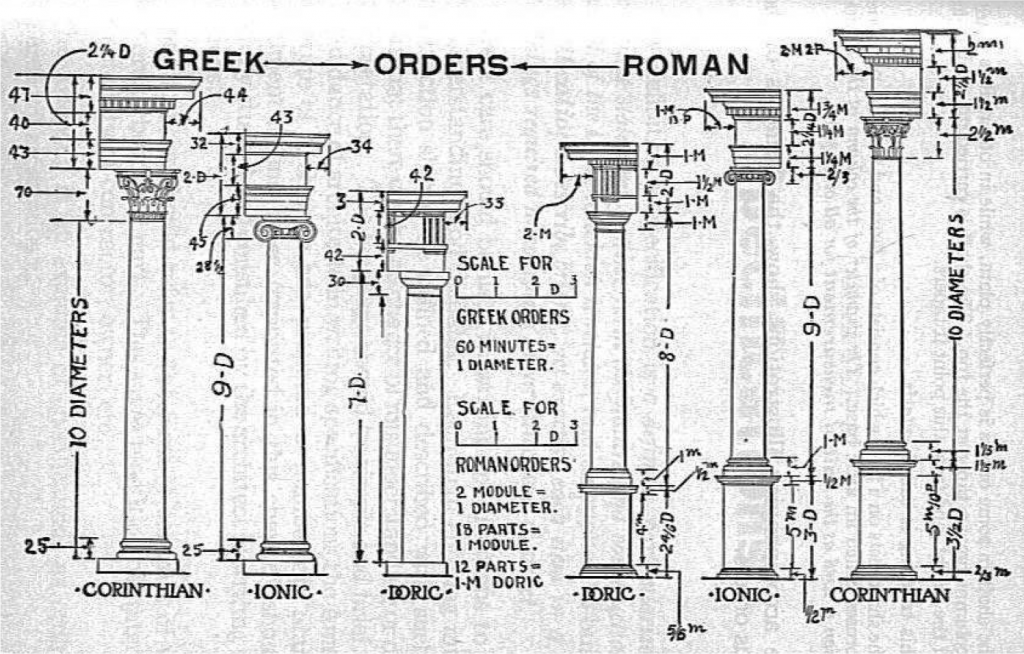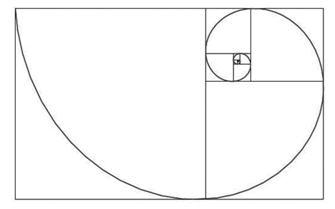A Formula for Beauty, Harmony & Unity
A Formula for Beauty, Harmony & Unity
The Classical system is influential because the ideals and philosophy behind the system is not only commonsensical but also works mathematically, visually and functionally. In truth, this Classical system is a system of beauty and harmony unity.
Greek & Roman Orders
In an earlier post we talked about why the Greeks and Romans used the human body as the proportioning system for their buildings. So what is that system? For each style: Doric, Ionic, and Corinthian, the proportions are based on each type of body. The male body inspired the Doric order, the female body the Ionic order, and the young maiden’s body the Corinthian order. How this works is most evident in the columns of each order. The Doric column has a ratio of 1:7. If the diameter of the column at the base is 1′ wide, than the height of the column is 7′ tall. In a Doric building, this 1:7 ratio establishes a proportional relationship for all the other elements in and on the building. All of the other parts of the building are scaled and proportional to the size of the column. The same system is true for the Ionic and Corinthian systems, as seen below.
The male body inspired the Doric order, the female body the Ionic order, and the young maiden’s body the Corinthian order.

The beautiful thing is that when using the Classical system these proportions and ratios encompass the entire building. Thus all the architectural elements, moldings, windows, doors, fireplaces, etc., would be tied in some way to the building’s order. What this means is that it was a pure and holistic system of building. Conceivably, if an owner requested a church to be built using the Ionic order, then with slight adjustments the master builder knew a great deal about the building, level of ornamentation, placement of windows, etc.
The beautiful thing is that when using the Classical system these proportions and ratios encompass the entire building.
This idea brought great comfort to the Greeks. It was the Greeks that produced the greatest society of thinkers; Socrates, Plato, Aristotle, and the mathematicians like Euclid for geometry and Pythagoras for math. There was no culture as obsessed with beauty and math and the sciences as the Greeks. They found inspiration in the human form, but it was not narcissistic attention to self that caused them to make the human form as a model. They discovered as they dug deeper that the parts and pieces of the human form are mathematically pure as well. What they found was a mathematical wonder called the golden mean.
They discovered as they dug deeper that the parts and pieces of the human form are mathematically pure as well.
.
The Golden Mean
The golden mean is seen most clearly in its geometrical form, the golden rectangle. This rectangle with a short side of 3 and long side of 5 give us the mathematical ratio of 5:3. This ratio is represented by the irrational number 1.6183… This number, whether represented geometrically or mathematically, holds some divine attributes.

The Renaissance mathematician Fibonacci reveals some of the magic of this number in his famous sequence, 1, 1, 2, 3, 5, 8, 13, 21, 34, 55, 89, etc. Known as the Fibonacci sequence, it mathematically represents the divine ideals of the golden mean. If we divide a lower number say, 55 into 89, it equals 1.618. This sequence of numbers is in turn tied to the proportions of rectangles found in the golden rectangle. For more fun, videos like this one show that this ratio has inspired and mystified scholars for years. For our study, and to the Greeks, this golden mean is found all over nature, in the growth of a pine cone, in the face of a sunflower, in the nautilus shell and of course the human body.
For our study, and to the Greeks, this golden mean is found all over nature, in the growth of a pine cone, in the face of a sunflower, in the nautilus shell and of course the human body.
.
5:3 in the Human Body & Architecture
This 5:3 ratio is found all over the human body. Leonardo da Vinci spent a great deal of time measuring all parts of the human body and comparing them to one another. He found this ratio again and again. It is thought by some to have helped define the face of Mona Lisa herself. This proportional ratio is found when we compare our overall height to the height of our belly button, in the hand to the forearm. It is like we have God’s fingerprint all over and throughout nature.
It is like we have God’s fingerprint all over and throughout nature.

The Greeks certainly saw this as an important ratio, and we see it throughout their famous temples as an overriding organizational tool.
It is this ability to organize, harmonize and beautify buildings according to a universal ideal that enthralled the Greeks. Beauty for them was order, balance and harmony. It was only natural that the math and order it wrought gave them such satisfaction. In order for us to build a timeless house, we must use these same rules, principles and proportions in our designs that were cherished by the early Greeks and Romans.
.

.
.
.
.
.
In order for us to build a timeless house, we must use these same rules, principles and proportions in our designs that were cherished by the early Greeks and Romans.

